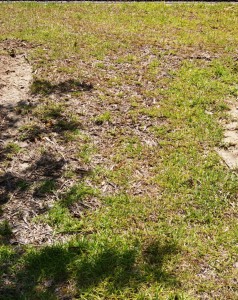With a few nice late winter days, many people get a good dose of spring fever. But be careful when the fever hits you. Don’t fertilize your lawn too early. The fever may turn into a lawn “headache”.
Wait to fertilize. Fertilizing while the soil is too cool can result in nutrient deficiencies such as iron deficiency causing yellow areas in the lawn. Fertilizing early can result in injury to a lawn’s roots from fertilizer burn. Or tender growth promoted by an early fertilizer application may be injured by a late frost or freeze. Have patience, allow the lawn to green up on its own and then fertilize, even if it’s not until mid April or May.
Get the numbers right. Our lawns need almost the same amount of potassium as compared to nitrogen. Getting this right can make a difference in the long-term health of your lawn. Look for a lawn fertilizer with an analysis such as 8-0-8, 10-0-10, 15-0-15, 18-0-18, 15-2-15, 16-0-8, etc. Look for a fertilizer with a 1:1 ratio of nitrogen to potassium. These numbers provide the buyer important information. The first number is the percent nitrogen (N), the second number is the percent phosphorus (P) and the third number is the percent potassium (K). Adequate potassium has been linked to reduced disease problems, drought and cold tolerance and enhanced root growth.
Use low phosphorus. Lawn grasses use much less phosphorus than nitrogen or potassium. Because of this and because phosphorus has been implicated as a cause for problems in our surface waters, it’s recommended to base phosphorus rates on the results of a reliable soil test. In absence of soil test results, select a fertilizer with 2% or less phosphorus such as 15-2-15, 8-0-8, 16-0-8, etc. It’s best to base P applications on the results of a reliable soil test.
Don’t fertilize too late. The latest month to fertilize our warm season lawn grasses in North Florida as recommended by University of Florida turfgrass researchers is mid September. If you have centipedegrass, it’s recommended to fertilize no later than July.
Measure your lawn. Most homeowners apply too much fertilizer because they do not know the square footage of their lawn. Measure the size of your lawn (front, back and side yard) and err on the side of using less fertilizer than recommended.
- Neighborhood Lawn Guru Kills Lawns, Leaves Town - March 22, 2024
- Rollercoaster Temperatures in NW Florida - February 8, 2024
- Muscadine Grapes, a Southern Treat - January 11, 2024

